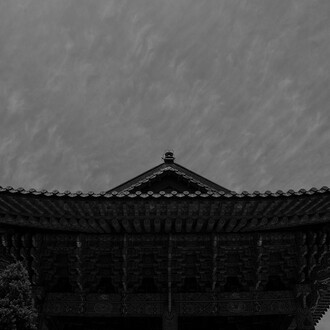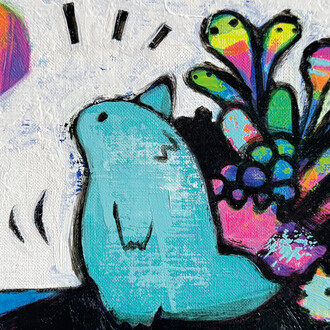To Become Life features Irina Rodnikoff—a Ukrainian multi-dsciplinary artist who works in installation, sculpture, and painting, alongside—and Miroslav Duzinkevich, a New York-based Ukrainian painter whose work is occasionally tinged with social realism. Kate Oh’s decision to display two Ukrainian artists in the midst of Russia's invasion of Ukraine is one that illuminates hope and bolsters the aesthetics of protest. Thus, it is poised in a history of art as protest; yet this response to Russian aggression is not simply one tethered to displaying artists from Ukraine but also indeclinably rooted in what kind of art is displayed. The content proffered by these artists is thus as critical to foreground.
It is significant that, despite a variation in subject matter and approach, these works each speak to the concept of "life" in unique modes. For instance, Duzinkevich's Calla Lilies takes organic forms of life and naturalism as its subject matter; muted-green stems swoop and arch-like bent backs are displayed while lavender-lilac petals rise. The gray backdrop, set across the politically-seeped backdrop of present-day Russia's aggression, unspools with metaphoric prowess. These could be war-cloaked flowers, or they very well could be flowers set across a dreary, gray rainy day. Yet these flowers are alive nevertheless, and hence artifacts of persistence. Still life with garlic is of an entirely different persuasion. There are no living organisms here but artifacts of a life lived: brown, painted pottery and a coffee mug are set beside long, spindly garlic upon a crimson-dotted tablecloth. This scene could very well be that of a home or restaurant, but the disheveled indices suggest life creeping at the margins. Notably, this work approaches the concept of life side-on, rather than directly. Paradise, blush-coral hued and heavenly, is the most celebratory of the works. Four beautifully dressed women hold hands, encircled in a dance, while a lone woman gazes out. The trees and skyline are plucked from a fuchsia-flush dream, while sprawling swans and a peacock decorate a red-crazed sidewalk. This is the most peaceful of the displayed works as well and can even be read to evoke heaven, the afterlife, or images of hope in the face of misfortune.
A number of more abstract works are also featured in the show, including Rodnikoff's Celestial Sail, Passage Thru Fire, and Urban Labyrinth Triptych. These works also utilize the aforementioned ethereal color palette of pink and glowing-maroon, with occasional splatters and streaks of expressive blemishes. It is tempting to read situational exigencies into these works (blood, turmoil, etc.) but perhaps one would do better to consider the cathartic act of splatter painting as such, and thus understand this painting more directly in line with the theme of "life”. To Become Life is thus an important show, not simply because it shows two Ukrainian artists but because of the subject matter that these works tactfully entertain.
















